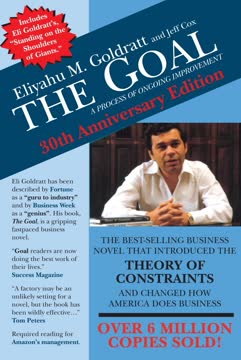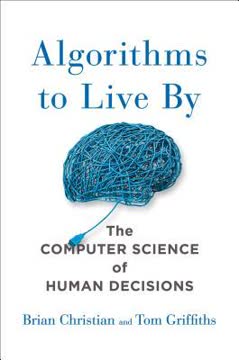Key Takeaways
1. Effective project portfolio management optimizes organizational value
You can do it all. Just not all at the same time.
Balance and prioritize. Project portfolio management is about organizing, seeing, and ranking all the work your organization needs to do. It allows you to focus on the most valuable projects while postponing or eliminating less critical ones. By aligning projects with strategic goals, you can maximize the return on your organization's time and resources.
Increase throughput. A well-managed portfolio reduces multitasking, eliminates "bright shiny object" syndrome, and prevents constant fire-fighting. Teams can focus on completing high-value work without interruptions. This leads to faster project completion, increased productivity, and a calmer work environment.
Adapt to change. Regular portfolio reviews allow you to reprioritize work based on changing market conditions or organizational needs. This flexibility ensures you're always working on what matters most, rather than blindly following outdated plans.
2. Collect and evaluate all work before ranking projects
If you're working on just one project, especially if your project is using timeboxes of up to four weeks and you work feature by feature so you finish valuable work at the end of each timebox, this is a trivial step. However, even if you're working in an agile way or if you're working on several projects, collect all your work anyway. You need to see what other people expect of you.
Be comprehensive. Gather all work across the organization, including:
- Ongoing operational work
- Maintenance and support tasks
- New product development
- Internal improvement initiatives
- Customer-facing projects
Categorize work. Organize collected work into meaningful categories:
- Projects vs. ongoing work
- Strategic vs. tactical initiatives
- Revenue-generating vs. cost-saving efforts
- Short-term vs. long-term investments
Initial evaluation. Before ranking, assess each piece of work:
- Does it align with organizational strategy?
- Is it still relevant and necessary?
- Are there dependencies or synergies with other work?
- What resources would be required?
3. Rank projects based on business value and strategic alignment
You collaborate on a portfolio for this reason: to make decisions at the organizational level—the highest level—not the lowest level.
Define value criteria. Establish clear metrics for assessing project value:
- Financial return (ROI, NPV, etc.)
- Strategic alignment
- Customer impact
- Risk reduction
- Regulatory compliance
- Innovation potential
Use consistent ranking methods. Choose appropriate techniques:
- Weighted scoring models
- Forced ranking
- Pairwise comparison
- Cost of Delay analysis
Consider constraints. Factor in resource limitations, dependencies, and timing:
- Available skills and capacity
- Budget restrictions
- Technology constraints
- Market windows or deadlines
4. Collaborate across the organization to make portfolio decisions
If you can't fully commit to a specific project, don't start it in this time period.
Break down silos. Portfolio decisions impact the entire organization, so involve key stakeholders:
- Senior leadership
- Product management
- Finance
- Marketing
- Technology leaders
Build trust and transparency. Foster an environment of open communication:
- Share portfolio data widely
- Explain decision rationale
- Address concerns and resistance
Facilitate effective meetings. Structure portfolio review sessions for productive outcomes:
- Prepare data in advance
- Set clear agendas and decision points
- Use visual aids to illustrate trade-offs
- Document and communicate decisions
5. Iterate on the portfolio regularly to adapt to changing priorities
When you manage the portfolio, reviewing the progress made on running, tested features by your teams, you don't need a serial life cycle, because you don't need the early milestones to attempt to gauge progress.
Set a review cadence. Establish a regular rhythm for portfolio evaluations:
- Monthly for fast-moving environments
- Quarterly for most organizations
- Align with budgeting and strategic planning cycles
Monitor project progress. Between reviews, track key indicators:
- Completed features or milestones
- Resource utilization
- Changing market conditions
- Emerging risks or opportunities
Make incremental adjustments. Use reviews to fine-tune the portfolio:
- Reallocate resources between projects
- Accelerate or decelerate timelines
- Add or remove projects as needed
6. Visualize the portfolio to improve communication and decision-making
Consider which visualization approach you need for a team's, group's, or organization's work. There is no right answer.
Choose appropriate visualizations. Select formats that resonate with your audience:
- Gantt charts for timelines
- Kanban boards for work in progress
- Bubble charts for comparing multiple factors
- Roadmaps for long-term planning
Highlight key information. Ensure visualizations clearly show:
- Project priorities and rankings
- Resource allocation
- Dependencies between projects
- Progress against goals
Keep it current. Regularly update portfolio visuals:
- Automate data collection where possible
- Make visualizations easily accessible
- Use real-time dashboards for dynamic views
7. Scale portfolio management across the enterprise
Do not try to "scale" the project portfolio using either one mode or the other. You need the details to discriminate among each project at the group or business unit level. You need the mission or strategy at the enterprise level to make large decisions.
Start small, then expand. Begin with a single team or business unit:
- Prove the concept
- Refine processes
- Build buy-in across the organization
Establish a hierarchy. Create a tiered approach to portfolio management:
- Team-level backlogs
- Department or product-line portfolios
- Enterprise-wide strategic portfolio
Maintain consistency. Ensure alignment across levels:
- Use common evaluation criteria
- Standardize reporting and metrics
- Create clear escalation paths for decisions
8. Evolve towards lean and agile portfolio approaches
If you don't have to think about projects anymore, you can use lean and agile approaches to making the portfolio decisions.
Focus on value delivery. Shift from project-centric to value-stream thinking:
- Organize work around customer-facing value streams
- Prioritize based on business outcomes, not project completion
Embrace incremental funding. Move away from annual budgeting:
- Fund initiatives in smaller increments
- Tie funding to demonstrated progress and value
- Allow for pivots based on learning
Implement pull-based systems. Use Kanban principles at the portfolio level:
- Limit work in progress (WIP)
- Pull new work only when capacity is available
- Visualize flow across the entire portfolio
9. Measure project and portfolio progress with meaningful metrics
Since you need to know what progress the team has made since the previous portfolio evaluation, you need to see current velocity and historical velocity.
Focus on outcomes. Prioritize metrics that demonstrate business value:
- Revenue generated or costs saved
- Customer satisfaction improvements
- Market share gains
- Innovation metrics (patents, new products launched)
Track team productivity. Use agile-friendly metrics to gauge progress:
- Velocity (story points completed per iteration)
- Cycle time (time from start to completion of work items)
- Throughput (number of items completed per time period)
Monitor portfolio health. Assess overall performance:
- Resource utilization across projects
- Alignment with strategic goals
- Balance of project types (innovation vs. maintenance)
- Risk profile of the portfolio
Last updated:
FAQ
What is "Manage Your Project Portfolio" by Johanna Rothman about?
- Project Portfolio Management Focus: The book centers on how to organize, visualize, and prioritize all the work your team or organization undertakes, aiming to increase capacity and finish more projects.
- Agile and Lean Principles: Rothman integrates agile and lean methodologies to help teams deliver value frequently and adaptively, using real data for decision-making.
- Collaboration and Leadership: Emphasizes that managing a project portfolio is a collaborative, leadership-driven process that aligns work with organizational mission and strategy.
Why should I read "Manage Your Project Portfolio" by Johanna Rothman?
- Solve Multitasking and Throughput Issues: The book provides practical solutions for teams struggling with too many simultaneous projects and low completion rates.
- Make Better Project Decisions: Offers tools and frameworks to help you decide which projects to commit to, kill, or transform, focusing on maximizing value.
- Improve Organizational Health: Shows how effective portfolio management can align projects with strategy, improve morale, and reflect the overall health of your organization.
What are the key takeaways from "Manage Your Project Portfolio" by Johanna Rothman?
- Commit/Kill/Transform Framework: Use a triage approach to decide the fate of each project, ensuring resources are focused on the most valuable work.
- Ranking by Value: Apply methods like Cost of Delay and business value points to collaboratively rank projects and prioritize staffing.
- Collaboration and Transparency: Build trust and foster open communication across teams and management to optimize organizational value.
How does Johanna Rothman define project portfolio management and its importance?
- Comprehensive Work Overview: Portfolio management involves collecting and visualizing all types of work—projects, ongoing tasks, emergencies, and management work.
- Strategic Alignment: Ensures that all projects and efforts are aligned with the organization’s mission and strategic goals.
- Continuous Adaptation: Encourages regular review and adaptation of the portfolio to respond to changes in strategy, market, or project progress.
What are the main agile and lean approaches recommended by Johanna Rothman for portfolio management?
- Frequent Value Delivery: Agile and lean enable teams to finish and deliver small, valuable increments of work, providing feedback for portfolio decisions.
- Adaptive Management: These approaches support changing priorities and project transformations based on real progress and evolving business needs.
- Visual Controls and WIP Limits: Use tools like kanban boards and limit work in progress to improve flow, transparency, and team focus.
How does "Manage Your Project Portfolio" by Johanna Rothman address multitasking and emergencies?
- Limit Multitasking: Advocates for teams to focus on one or two projects at a time to increase throughput and morale.
- Portfolio-Driven Emergency Management: Regular portfolio reviews help identify and reduce emergencies by prioritizing and addressing technical or management debt.
- Lean Pull Systems: Implement pull systems to ensure teams complete current work before starting new tasks, reducing overproduction and chaos.
What methods does Johanna Rothman recommend for ranking and prioritizing projects in a portfolio?
- Collaborative Ranking: Involve peers and stakeholders in ranking projects to ensure balanced perspectives and shared commitment.
- Cost of Delay and Value Points: Use quantitative methods like Cost of Delay and business value points to prioritize projects based on impact.
- Pairwise Comparison and Elimination: When value points are hard to assign, use pairwise comparisons or elimination tournaments to determine project priority.
How should organizations create and visualize their first project portfolio according to Rothman?
- Collect All Work: Gather every type of work within your influence, including ongoing, emergency, and management tasks, for a complete picture.
- Use Physical Tools: Start with sticky notes or index cards to visualize work by week and by person, making it easier to discuss and adjust.
- Organize by Programs: Identify interdependent projects and group them into programs for more effective management and oversight.
What are the best practices for collaboration and decision-making in project portfolio management from Rothman’s perspective?
- Build Trust: Foster trust by delivering on promises, being consistent, and practicing integrity to enable effective collaboration.
- Define Principles and Mission: Clearly articulate the principles behind project ranking and align decisions with the organizational mission.
- Structured Portfolio Meetings: Hold agenda-driven meetings to review, rank, and make commit/kill/transform decisions, ensuring transparency and shared understanding.
How does Johanna Rothman suggest organizations handle transparency, information sharing, and zero-sum thinking?
- Promote Transparency: Encourage open sharing of progress, velocity, and backlog information to enable informed portfolio decisions.
- Overcome Information Hiding: Address resistance to sharing status by demonstrating the benefits of visibility for throughput and emergency reduction.
- Shift from Zero-Sum to Organizational Goals: Move the focus from individual project wins to collective organizational success, reducing internal competition and fostering collaboration.
What are common traps and mistakes to avoid in project portfolio management according to Rothman?
- Confusing Value and Effort: Don’t mix business value points (value) with story points (effort), as this leads to poor prioritization.
- Ignoring Risky Projects: Avoid excluding high-risk projects, as they may offer significant opportunities; manage risk incrementally.
- Misusing Roadmaps: Don’t treat the portfolio as a product roadmap; the portfolio optimizes work across the organization, not just for a single product.
How does "Manage Your Project Portfolio" by Johanna Rothman recommend scaling portfolio management and measuring success in large organizations?
- Balance Top-Down and Bottom-Up: Combine detailed project-level data with high-level strategic alignment across business units for effective scaling.
- Address Silos and Incentives: Tackle challenges like functional silos and misaligned incentives by adjusting compensation and organizational structures.
- Measure Team Throughput: Track running, tested features, velocity, and work in progress at the team level, avoiding individual productivity metrics for more meaningful insights.
Review Summary
Manage Your Project Portfolio receives mixed reviews, with an average rating of 3.71/5. Positive reviews praise its practical advice on prioritizing projects, reducing multitasking, and improving team efficiency. Readers appreciate the book's lean principles and leadership insights. Some find it essential for software managers and product teams. Critical reviews mention lack of depth, repetitiveness, and over-reliance on agile methodologies. The book is seen as a good introduction to project portfolio management, particularly useful for those new to the concepts.
Similar Books








Download PDF
Download EPUB
.epub digital book format is ideal for reading ebooks on phones, tablets, and e-readers.





